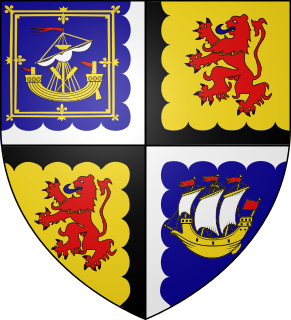Related Research Articles
There are currently two earldoms of Mar in the Peerage of Scotland, and the title has been created seven times. The first creation of the earldom is currently held by Margaret of Mar, 31st Countess of Mar, who is also clan chief of Clan Mar. The seventh creation is currently held by James Erskine, 14th Earl of Mar and 16th Earl of Kellie, who is also clan chief of Clan Erskine.

The title Earl of Kellie or Kelly is a title in the Peerage of Scotland, created in 1619 for Sir Thomas Erskine, who was Captain of the Guard and Groom of the Stool for James VI. It is named after Barony of Kellie in Fife, Scotland. Since 1875, it has been held jointly with the Earldom of Mar.

The Mormaer or Earl of Buchan was originally the provincial ruler of the medieval province of Buchan. Buchan was the first Mormaerdom in the High Medieval Kingdom of the Scots to pass into the hands of a non-Scottish family in the male line. The earldom had three lines in its history, not counting passings from female heirs to sons. Today it is held by the Erskine family as a peerage. The current holder is Malcolm Erskine, 17th Earl of Buchan.

Earl of Caithness is a title that has been created several times in the Peerage of Scotland, and it has a very complex history. Its first grant, in the modern sense as to have been counted in strict lists of peerages, is now generally held to have taken place in favor of Maol Íosa V, Earl of Strathearn, in 1334, although in the true circumstances of 14th century, this presumably was just a recognition of his hereditary right to the ancient earldom/mormaership of Caithness. The next year, however, all of his titles were declared forfeit for treason.
The Lord Chancellor of Scotland was a Great Officer of State in the Kingdom of Scotland.

William Cunningham, 9th Earl of Glencairn (1610–1664), was a Scottish nobleman, Lord Chancellor of Scotland, and a cavalier. He was also the chief of Clan Cunningham.

James Hamilton, 2nd Marquess of Hamilton and 4th Earl of Arran KG PC, styled Lord Aven from 1599 to 1604, was a Scottish politician. He was the son of John Hamilton, 1st Marquess of Hamilton and Margaret Lyon.
Lord Cardross is a title in the Peerage of Scotland, since 1695 a subsidiary title of the earldom of Buchan. It was created in 1606 for John Erskine, Earl of Mar, with remainder to his heirs male and assignees whatsoever and with the power to nominate his successor. In 1617 he nominated his second son by his second wife Marie Stewart, Henry Erskine, Master of Cardross, to be his successor in the lordship of Cardross. The Earl of Mar died in 1634 and was succeeded in the earldom of Mar by his son by his first wife, John, and in the lordship of Cardross by his grandson David Erskine, the second Lord Cardross, the son of Henry, Master of Cardross, who had died in 1628. The second Lord was a supporter of The Engagement and was barred from sitting in Parliament in 1649. He was succeeded by his eldest son, the third Lord. He emigrated to North America to escape religious persecution and established a colony in what is now Carolina. His son, the fourth Lord, succeeded his kinsman in the earldom of Buchan in 1695. However, it was not until 1698 that his claim was established by the Scottish Parliament. For further history of the title, see Earl of Buchan.
The Battle of Sauchieburn was fought on 11 June 1488, at the side of Sauchie Burn, a stream about two miles south of Stirling, Scotland. The battle was fought between the followers of King James III of Scotland and a large group of rebellious Scottish nobles including the future Alexander Home, 2nd Lord Home, who were nominally led by the king's 15-year-old son, Prince James, Duke of Rothesay.
Robert Stewart, 1st Earl of Orkney and Lord of Zetland (Shetland) was a recognised illegitimate son of James V, King of Scotland, and his mistress Eupheme Elphinstone. Robert Stewart was half-brother to Mary, Queen of Scots and uncle to James VI and I of Scotland and England.
David Stewart, Prince of Scotland, was a 14th-century Scottish magnate. He was the eldest son of the second marriage of King Robert II with Euphemia de Ross. King Robert, on 26 March 1371, the day of his coronation, created him Earl of Strathearn, and on the following day his son David performed homage to his father as of Earl of Strathearn.
James Cunningham, 7th Earl of Glencairn (1552–1630) was a Scottish peer and member of the Privy Council of Scotland.
Hugh Montgomerie, 1st Earl of Eglinton was a Scottish peer.
Thomas Erskine, 2nd Lord Erskine, was a Scottish peer. His family was claimant to the earldom of Mar; this was recognized in 1565 for Thomas' descendant, John Erskine. Following a dynastic dispute in the 19th century, Thomas was acknowledged, retrospectively, as the 14th Earl.

James Erskine, 6th Earl of Buchan, was the eldest son of John Erskine, Earl of Mar, by his second wife, Marie Stewart, daughter of Esme Stewart, Duke of Lennox.
William Sempill, 2nd Lord Sempill was a Scottish lord and Sheriff of Renfrewshire.
Alexander Montgomerie, 6th Earl of Eglinton (1588–1661) was a Scottish aristocrat and soldier, originally known as Sir Alexander Seton of Foulstruther.
Alexander Livingston, 2nd Earl of Linlithgow PC was a Scottish nobleman.
References
- Sir George Mackenzie of Rosehaugh, "Observations upon the Laws and Customs of Nations as to Precedency", pp. 27-9, included in the sixth edition of John Guillim's A Display of Heraldry (London, 1724).
- ↑ The Earl of Crawford, The Earldom of Mar in Sunshine and in Shade, vol. ii (Edinburgh, 1882) pp. 34–35.
- ↑ Crawford, pp. 36–37.